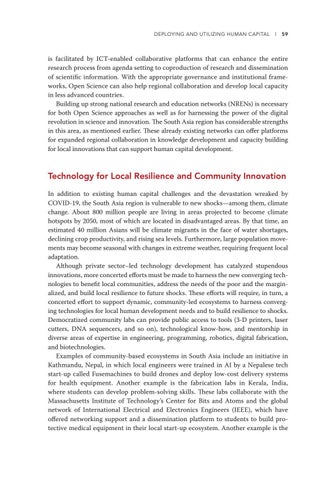Deploying and Utilizing Human Capital l 59
is facilitated by ICT-enabled collaborative platforms that can enhance the entire research process from agenda setting to coproduction of research and dissemination of scientific information. With the appropriate governance and institutional frameworks, Open Science can also help regional collaboration and develop local capacity in less advanced countries. Building up strong national research and education networks (NRENs) is necessary for both Open Science approaches as well as for harnessing the power of the digital revolution in science and innovation. The South Asia region has considerable strengths in this area, as mentioned earlier. These already existing networks can offer platforms for expanded regional collaboration in knowledge development and capacity building for local innovations that can support human capital development.
Technology for Local Resilience and Community Innovation In addition to existing human capital challenges and the devastation wreaked by COVID-19, the South Asia region is vulnerable to new shocks—among them, climate change. About 800 million people are living in areas projected to become climate hotspots by 2050, most of which are located in disadvantaged areas. By that time, an estimated 40 million Asians will be climate migrants in the face of water shortages, declining crop productivity, and rising sea levels. Furthermore, large population movements may become seasonal with changes in extreme weather, requiring frequent local adaptation. Although private sector–led technology development has catalyzed stupendous innovations, more concerted efforts must be made to harness the new converging technologies to benefit local communities, address the needs of the poor and the marginalized, and build local resilience to future shocks. These efforts will require, in turn, a concerted effort to support dynamic, community-led ecosystems to harness converging technologies for local human development needs and to build resilience to shocks. Democratized community labs can provide public access to tools (3-D printers, laser cutters, DNA sequencers, and so on), technological know-how, and mentorship in diverse areas of expertise in engineering, programming, robotics, digital fabrication, and biotechnologies. Examples of community-based ecosystems in South Asia include an initiative in Kathmandu, Nepal, in which local engineers were trained in AI by a Nepalese tech start-up called Fusemachines to build drones and deploy low-cost delivery systems for health equipment. Another example is the fabrication labs in Kerala, India, where students can develop problem-solving skills. These labs collaborate with the Massachusetts Institute of Technology’s Center for Bits and Atoms and the global network of International Electrical and Electronics Engineers (IEEE), which have offered networking support and a dissemination platform to students to build protective medical equipment in their local start-up ecosystem. Another example is the

